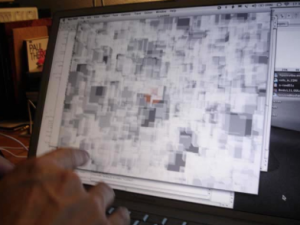Max for Live objects
By Florian Zand
by Florian Thalmann
More about BigBang Rubette: http://link.springer.com/chapter/10.1007/978-3-642-00148-2_17#page-1
Max clippings for Ableton Push
By Mark Egloff
Dowload: Media:MFL-Push_Package.zip Copy the “Ableton Push” folder into the Max 6.1 Packages folder.
Cycling 74 tutorial. https://cycling74.com/wiki/index.php?title=Push_Programming_Oct13_01
Pitch Tracker and Autotuna M4L devices without Live.
https://github.com/tkzic/max-projects
folder: pitchtracking
patch: autotuna-test.maxpat
Audio data for Visualization and Introduction to Open GL
Generally, visualizations will track amplitude, pitch – or any characteristic of audio that is changing over time.
dude837 – “Delicious Max 6 Tutorial 21: Bump It” (with physics simulation) – note: during the class, we didn’t actually get this patch to work. Patches for dude837 tutorials: http://otherbirds.com/tutorials/
Next week we will look at some of your work in progress for the midterm assignment (that will be due by March 31. Please be ready to demonstrate something or you will have to listen to me again.
The Live Object Model in Max for Live.
Several ways of working with Ableton Live parameters in a M4L patch. (This is an improved version of the patch we built in class) https://reactivemusic.net/?p=18401
The Live Object Model description: https://cycling74.com/docs/max5/refpages/m4l-ref/m4l_live_object_model.html
In the coming weeks we will build synthesizers and work with control surfaces in M4L
Build 3 or more M4L devices, including one of each of the following
Its ok to adapt and “improve” an existing device.
Please bring in your work in progress for next week and be prepared to demonstrate something. The entire assignment will not be due until March 31.
Introduction to getting, setting, and observing Live parameters with Max for Live.
https://github.com/tkzic/max-for-live-projects
folder: lom
patch: aaa-lom-examples
This example device shows several ways of working with Ableton Live parameters in a M4L patch. It can be a confusing process. And there are many different ways to accomplish the same result.
The examples here will use the LOM (Live Object Model) directly, and via builtin LiveAPI abstractions and choosers – available from the context menu that appears when you <ctrl> click inside of an open patcher window.
The snippet above shows how to continuously monitor Live’s tempo.
The snippet above shows how to set Live’s tempo.
The snippet above shows how to get Live’s tempo.
The snippet above shows how to start or stop the Live transport by calling functions.
The LiveAPI abstractions provide convenient shortcuts to working with Live parameters. Copy them into your patch by <ctrl> clicking inside an open (unlocked) patcher window – and selecting “Paste from -> LiveAPI abstractions”
The snippet above shows how to monitor whether the Live transport is running
The snippet above shows how to select the Master track
The LiveAPI choosers provide convenient shortcuts to selecting Live parameters from menu objects. Copy them into your patch by <ctrl> clicking inside an open (unlocked) patcher window – and selecting “Paste from -> LiveAPI choosers”
The snippet above shows how to remotely set the volume on the master track
“Boids is a bird flight and animal flock simulator. It is based on the same algorithm which was used in “Jurassic Park” for herding dinosaurs.”
Max external by Singer, Jasch, Sier and Smith. Tutorial by dude837
https://github.com/tkzic/max-projects
folder: boids
project: boids23
patch: main-tz.maxpat (slight modification to enable existing presets to work)
